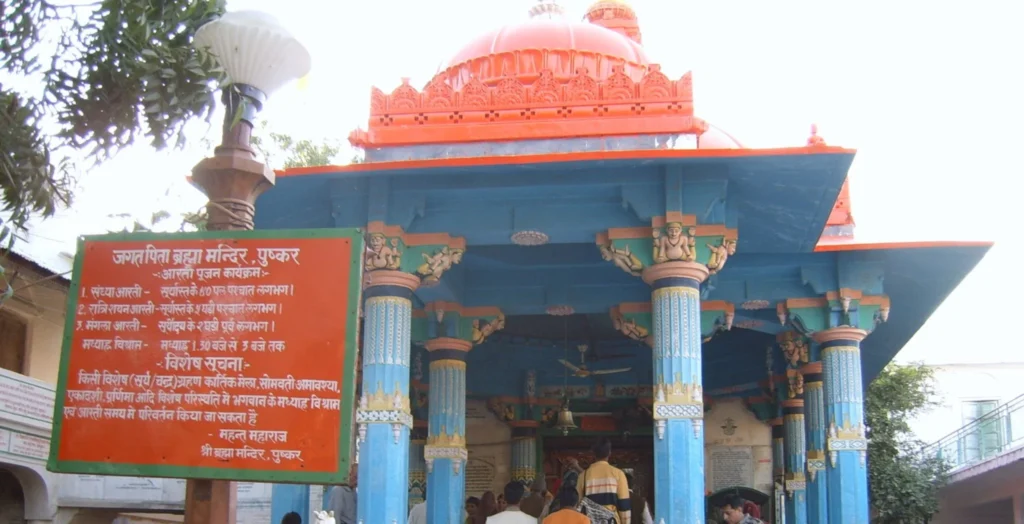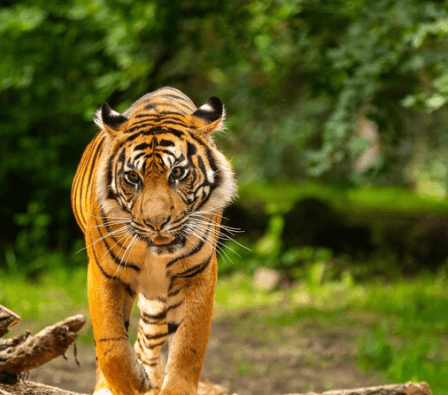Welcome to the Brahma Temple, a spiritual haven nestled in the holy town of Pushkar, Rajasthan.
This revered shrine, the Jagatpita Brahma Mandir, is the most famous Hindu temple dedicated to Lord Brahma, the world’s creator. Besides being a singular temple for Brahma in India, it draws lakhs of pilgrims annually.
Initially constructed in the 14th century, the Brahma temple Pushkar is considered 2000 years old and was initially built by sage Vishwamitra. Furthermore, it underwent significant renovations by Adi Shankara.
Moreover, this temple is constructed from marble and enormous stone slabs and houses images of lord Brahma temple with his two wives, Gayatri and Savitri.
In addition, the sacred Pushkar Lake flowing right before the temple amplifies its sanctity. Lastly, visiting Kartik Poornima elevates the spiritual experience, making it a must-visit destination.
History of the Brahma Temple in Pushkar
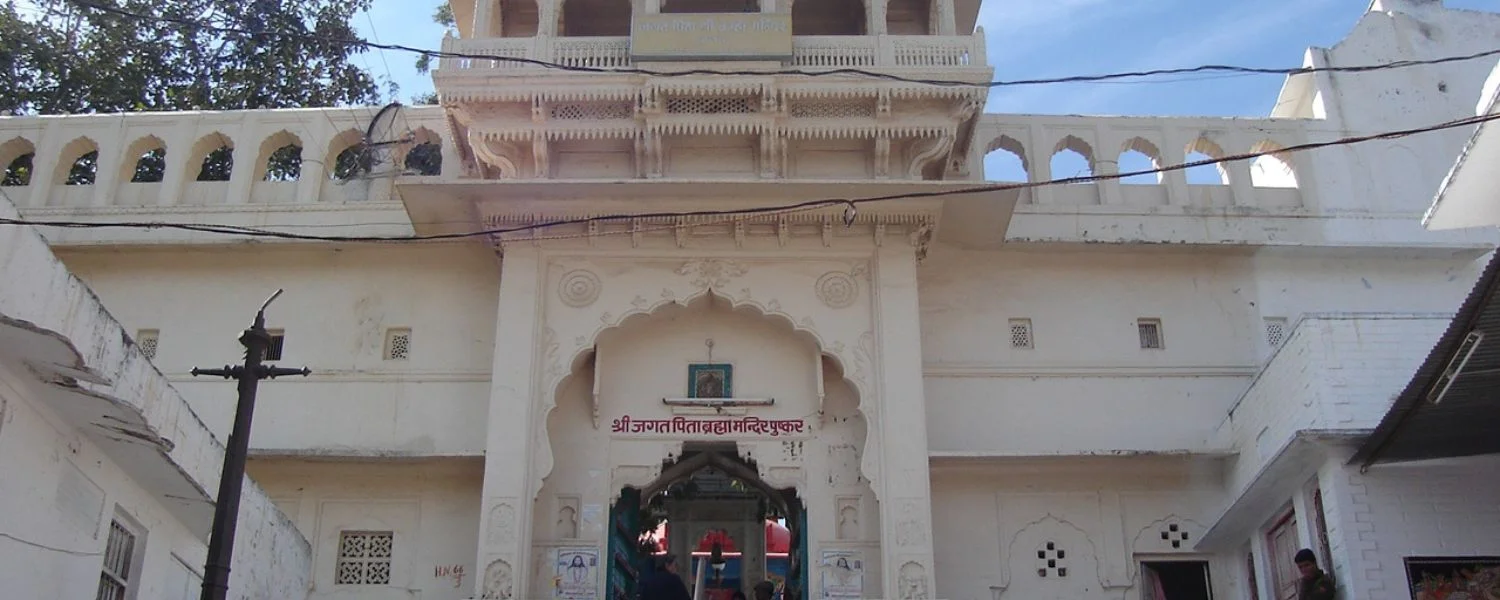
Pushkar is renowned for its 500 temples, 80 large and the small. Many ancient temples were destroyed or desecrated during the rule of Mughal emperor Aurangzeb (1658–1707) but later rebuilt.
The Brahma temple in India is the most important of Pushkar’s temples and dates back to the 14th century. It is said to have been built by the sage Vishwamitra after Brahma’s yagna (ritual).
Moreover, Brahma himself is believed to have chosen the location for his temple. The 8th-century Hindu philosopher Adi Shankara renovated this temple, and the current medieval structure dates to Maharaja Jawat Raj of Ratlam, who made repairs, though the original design is retained.
Pushkar is often described in scriptures as the only Brahma temple in the world due to the curse of Savitri (Saraswati) and is known as the “King of the sacred places of the Hindus.”
However, it is no longer the only Brahma temple; it remains one of the few temples devoted to Brahma in India and is the most prominent.
An article in the International Business Times identifies Pushkar Lake and the Brahma Temple as one of the ten religious cities in the world and one of the five pilgrimage places for Hindus in India.
Legend of the Brahma Temple in Pushkar
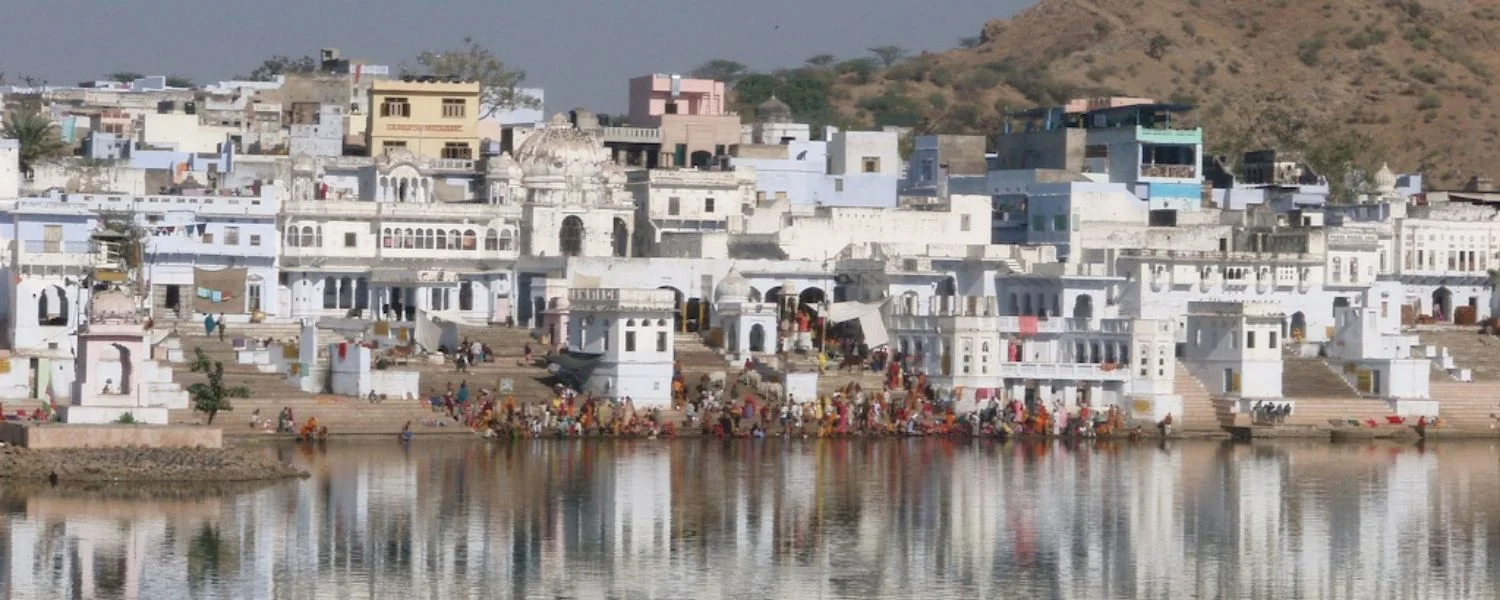
However, according to the Hindu scripture Padma Purana, Brahma saw the demon Vajranabha (or Vajranash in another version) trying to kill his children and harass people.
However, immediately slew the demon with his weapon, the lotus flower. Furthermore, the lotus petals fell on the ground at three places, creating three lakes such as Pushkar Lake or Jyeshta Pushkar, Madya Pushkar Lake, and Kanishta Pushkar lake.
Brahma then performed a yajna (fire sacrifice) at the main Pushkar Lake.
Furthermore, to perform his yajna peacefully without being attacked by demons, he created the hills around Pushkar — Ratnagiri (south), Nilgiri in the north, Sanchoora (west), and Suryagiri (east) — and positioned gods there to protect the yajna.
Additionally, while performing the yajna, his wife Savitri could not be present at the designated time to perform the further part of the yajna she was waiting for her companion Lakshmi, Parvati, and Indrani.
However, Brahma married an Abhira girl, Gayatri, and completed the yajna with his is sitting beside him, further holding the pot of amrita on her head and giving ahuti. However, you can also explore the historical places in Rajasthan.
Architecture of Brahma Temple
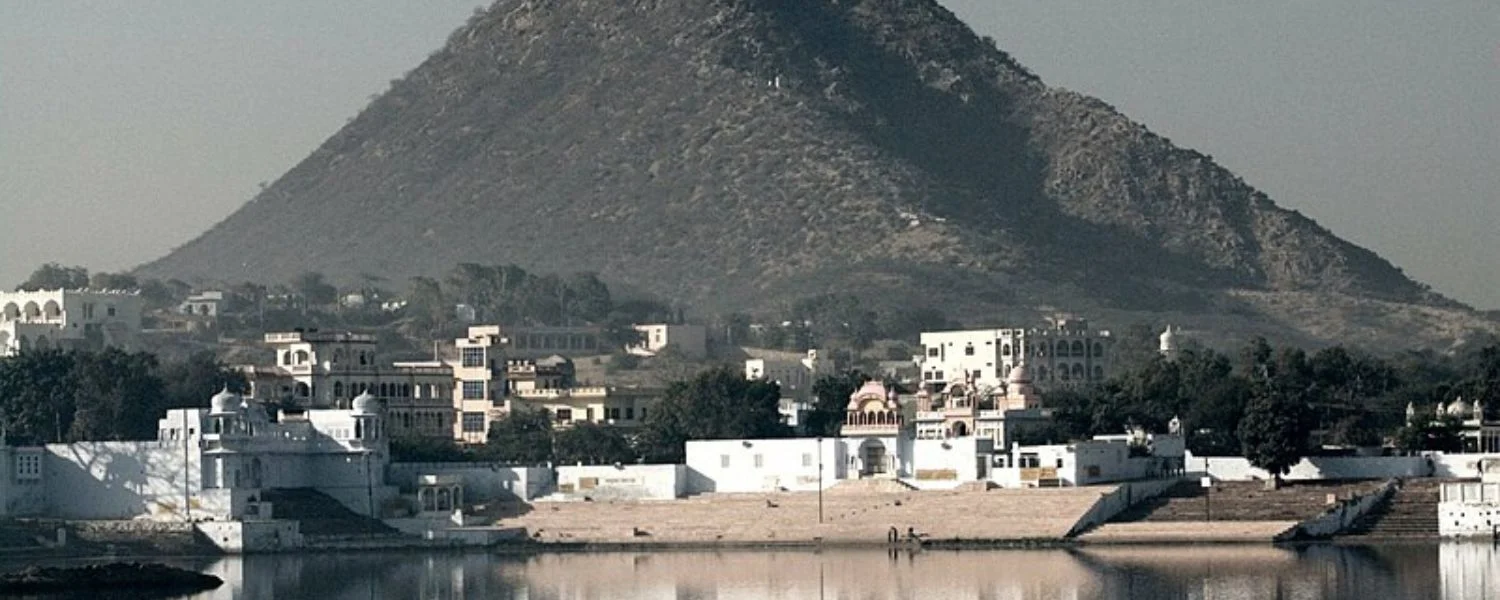
The Brahma Temple is an architectural marvel set on a high plinth, approached through a series of marble steps further leading to an entrance gate archway.
This archway is beautifully decorated with pillared canopies. Next, the entry from the gate leads to a pillared outdoor hall known as the Mandapa and then to the sanctum sanctorum or Garbhagriha.
Moreover, the temple is constructed using stone slabs and blocks joined together with molten lead.
The temple’s distinct features include its red shikhara (spire), which stands approximately 70 feet (21 meters) high, and the hamsa motif (a swan or goose), which is the mount of Brahma, adorning the main entry gate.
Inside the temple, the black and white checkered marble floor and walls are inlaid with hundreds of silver coins, each inscribed with the names of devotees as offerings to Brahma.
Equally important, a silver turtle is displayed on the floor of the mandap facing the Garbhagriha, which is also constructed of marble. The marble flooring has been replaced periodically to maintain its pristine condition.
Worship
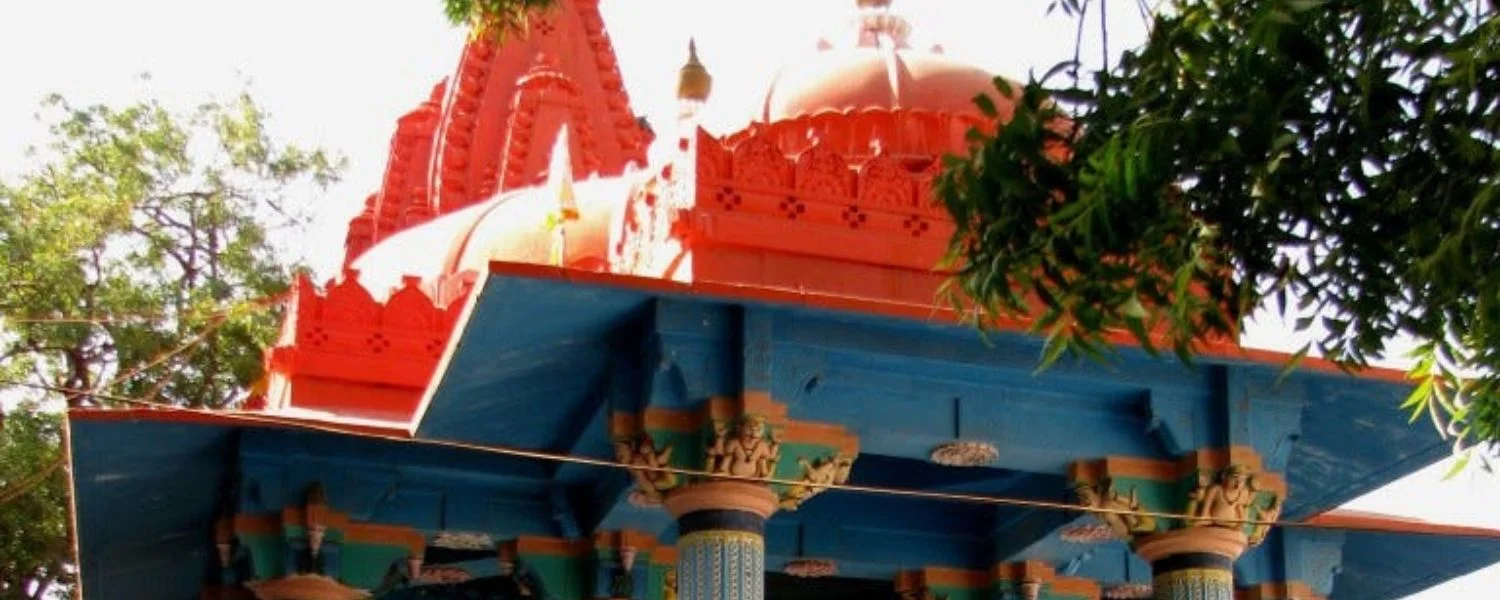
The Brahma Temple is a significant pilgrimage site visited by numerous devotees, holy men, and sages. They customarily take a sacred bath in the Pushkar Lake before entering the temple.
Furthermore, it is a tradition that after visiting the Brahma Temple, pilgrims also worship their consort, Gayatri, and then visit other nearby temples as convenient.
The temple is open for worship from 6:30 a.m. to 8:30 p.m. during winter and from 6:00 a.m. to 9:00 p.m. during summer. There is an afternoon interval from 1:30 p.m. to 3:00 p.m. when the temple remains closed.
Additionally, three artis are conducted daily: Sandhya arti in the evening, further about 40 minutes after sunset; Ratri Shayan arti, around five hours past sunset; and Mangala arti in the morning, approximately two hours before sunrise.
Notably, the priests at the Brahma Temple follow a strict religious practice. However, married men are not permitted to enter the sanctum sanctorum to worship the deity; further only ascetics (sanyasis) are allowed this privilege.
As a result, all offerings made by pilgrims are made by a priest from the outer hall of the temple. The priests, generally belonging to the Parashar gotra (lineage), manage the temple rituals.
Once a year, on Kartik Poornima, the whole moon night of the Hindu month of Kartik, however, a grand festival is held in honor of Brahma.
Furthermore, thousands of pilgrims bathe in the holy Pushkar Lake adjacent to the temple, and various rites are conducted at the temple during this fair.
This day also coincides with the famous Pushkar Camel Fair, held nearby. Additionally, special rites are performed on all Poornima (full moon days) and Manassas (new moon days).
Other related temples
A. Temples of Brahma’s Consorts
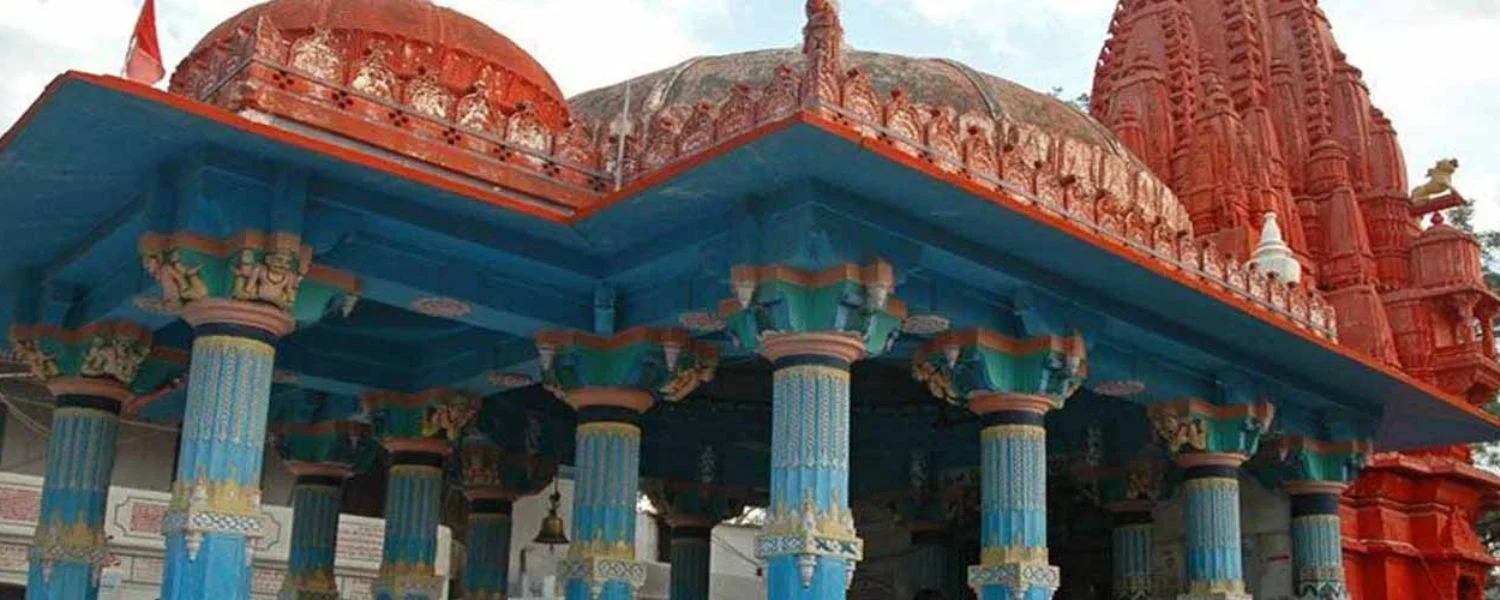
Brahma’s two consorts, Savitri and Gayatri, have separate temples dedicated to them in Pushkar. These temples are located on hills at opposite ends of the Pushkar Lake.
Savitri, who cursed Brahma, remains seated in her shrine on the highest hill in Pushkar, still described as annoyed and enraged.
Her temple is on Ratnagiri Hill, behind the Brahma Temple, and provides a spectacular view of the Pushkar Lake and the dunes to the west.
Reaching this temple requires a one-hour trek up a series of steps. The temple, made of marble, houses a statue of Goddess Savitri. An early morning visit offers a breathtaking view of the lake.
On the other hand, Gayatri, who feared Savitri’s wrath, sits on a lower hill on the eastern side of the lake. Her temple is also significant, strategically lower than Savitri’s, symbolizing her fear and respect.
Together, these temples add a spiritual charm to the town of Pushkar, enhancing its sacred landscape and more about Rajasthan. You can explore authentic Rajasthani food in Udaipur.
B. Atpateshwar or Apteshwar Temple

In addition to the temples of Brahma’s consorts, the Atpateshwar Temple, dedicated to Shiva, is another noteworthy shrine in Pushkar.
This temple, located in a cave next to the Brahma Temple, has a fascinating legend associated with its origin. It is said that Brahma built this temple after a unique encounter with Shiva.
During a yagna performed by Brahma, Shiva attended in the guise of a Tantric mendicant holding a skull. When confronted, Shiva filled the entire yagna site with skulls.
Realizing his mistake and understanding that the mendicant was Shiva, Brahma meditated and invited Shiva to the yagna. In appreciation, Brahma built the Atpateshwar Temple.
The temple houses a large Shiva Linga encircled by a copper snake, making it a distinctive worship site. The Shivaratri festival is an extraordinary occasion to visit this temple, as it draws numerous devotees.
C. Asotra temple

However, the Asotra Temple, the second largest Brahma Temple, is situated in the Balotra district of Rajasthan. This magnificent temple, primarily dedicated to Brahma, was established by the Rajpurohit of the village.
It is constructed using Jaisalmer and Jodhpur stone; however, the deity idol is crafted from marble. Furthermore, the temple is known for its unique tradition of feeding birds over 200 kg of grain daily.
Besides its architectural beauty, the Asotra Temple holds significant cultural and religious importance. Lastly, this temple attracts devotees and bird lovers, making it a unique destination. In addition, its serene environment provides a peaceful retreat for visitors.
Conclusion
In conclusion, the Brahma Temple in Pushkar is a testament to architectural grandeur and spiritual significance.
This unique temple, dedicated to Lord Brahma, offers a profound connection to ancient Hindu traditions and mythology.
Moreover, its intricate design, sacred rituals, and stunning surroundings, including the holy Pushkar Lake, create a mesmerizing experience for visitors.
Lastly, the temple’s rich history and vibrant cultural festivities during Kartik Poornima further elevate its importance as a pilgrimage site. The Brahma Temple, with its timeless beauty and deep spiritual resonance, continues to captivate and inspire devotees and tourists alike.
FAQ
Q. Why does Brahma have only one temple?
A. Savitri, enraged when she learned that her husband had wed another lady, cursed Brahma that his followers would only worship him in Pushkar. Thus, per legend, the Brahma Temple in Pushkar is further the only temple dedicated to Lord Brahma in India.
Q., How many Brahma Ji temples are there in India?
A. Brahma is one of the three principal deities of Hinduism. He is depicted with four heads and sits on a lotus flower. Brahma is also the creator of the Vedas and other ancient Hindu scriptures.
Q. Why is the Brahma temple only in Pushkar?
A. Enraged by her husband’s second marriage, Savitri cursed Brahma, stating that he wouldn’t be worshipped elsewhere. However, Gayatri lessened the curse’s effects. Thus, the temple in Pushkar was reserved for Brahma’s worship.
Q. Is there only one Brahma temple in the world?
A. Although the Pushkar temple is no longer the only Brahma Temple, it is still one of the few existing temples dedicated to Brahma in India and is the further, most prominent among them.
